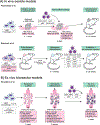Engineering human hematopoietic environments through ossicle and bioreactor technologies exploitation
- PMID: 33278488
- PMCID: PMC7879567
- DOI: 10.1016/j.exphem.2020.11.008
Engineering human hematopoietic environments through ossicle and bioreactor technologies exploitation
Abstract
The bone marrow microenvironment contains cellular niches that maintain the pool of hematopoietic stem and progenitor cells and support hematopoietic maturation. Malignant hematopoietic cells also co-opt normal cellular interactions to promote their own growth and evade therapy. In vivo systems used to study human hematopoiesis have been developed through transplantation into immunodeficient mouse models. However, incomplete cross-compatibility between the murine stroma and transplanted human hematopoietic cells limits the rate of engraftment and the study of relevant interactions. To supplement in vivo xenotransplantation models, complementary strategies have recently been developed, including the use of three-dimensional human bone marrow organoids in vivo, generated from bone marrow stromal cells seeded onto osteo-inductive scaffolds, as well as the use of ex vivo bioreactor models. These topics were the focus of the Spring 2020 International Society for Experimental Hematology New Investigator webinar. We review here the latest advances in generating humanized hematopoietic organoids and how they allow for the study of novel microenvironmental interactions.
Copyright © 2020 ISEH -- Society for Hematology and Stem Cells. Published by Elsevier Inc. All rights reserved.
Figures

References
Publication types
MeSH terms
Grants and funding
LinkOut - more resources
Full Text Sources
Other Literature Sources
Medical

